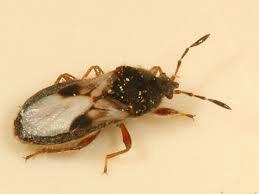How to Identify Chinch Bugs

The issue we are going to cover this week is the chinch bug insect. The hairy chinch bug is quite common in Pennsylvania, and they love to infest open, sunny areas on the lawn. You generally will not find them in shaded areas; they will be in the sunny portions of the turf surrounding a shaded area. These surface feeding insects, when adult, are about 1/6 of an inch in length and have a gray/black body with fine hairs, white wings and reddish legs.
Recognize Chinch Bug Damage
As previously stated, chinch bugs are not easy to see. As an adult, they are only 1/6 of an inch in length. Unfortunately, your grass will generally tell you if your lawn’s been attacked by chinch bugs. Your grass will look like it’s suffering from drought. Along the perimeter of your driveway, your grass blades wilt and turn into a brown-yellow color, then dry out and die. If you’ve seen these signs, but are unsure if the damage was caused by chinch bugs, call one of our professions today!
These insects feed on the plant by sucking out the nutrients and injecting a toxin into the plant which causes the turf to turn yellow/brown and eventually die off. These infected patches normally will join to create a larger area. To find chinch bug activity, you will need to get on your hands and knees and inspect the areas close up.
Recognize a Chinch Bug

Recognize a Chinch Bug
A quick and easy way to ID chinch bugs if you cannot see them by eye, is to have a tuna can with both sides cut out, and embed the can into the soil about an inch down, then fill with water. The bugs will float to the surface. If you ID chinch bugs on the lawn, we would recommend multiple surface feeding insect treatments, depending on the damage. More than likely, seeding will also need to be done to repair dead turf.
You will want to check the healthy looking turf around the affected area, as the bugs have already killed off the browned patches and moved on the unaffected nearby turf. This activity is commonly misidentified as drought stress, as both show the same appearance and chinch bug activity ramps up in early July/August in correlation with hot/drought stressed conditions.
These invasive surface feeding insects will suck your grass blades dry. If not cared for in a professional manner, your grass blades will be injected with a poison that slowly kills them. They can and will kill patches or your entire lawn if not treated for. But, you can get even with professional surface feeding insect control today! Get $10 off each application when you sign up for a program!